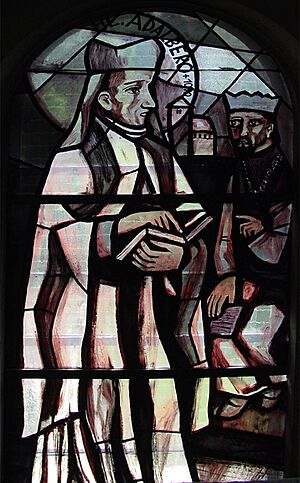Adalbero of Würzburg facts for kids
Quick facts for kids SaintAdalbero of Würzburg |
|
|---|---|

Adalbero in stained glass in the parish church of Liesing
|
|
| Bishop | |
| Born | c. 1010 Lambach an der Traun |
| Died | 6 October 1090 Lambach an der Traun |
| Canonized | 1883 by Pope Leo XIII |
| Feast | 6 October |
Adalbero of Würzburg (born around 1010 – died October 6, 1090) was an important leader in the church. He was the Bishop of Würzburg and also a count from the Lambach-Wels family. People remember him as a saint.
Contents
Life of Saint Adalbero
Early Life and Education
Adalbero was born around the year 1010 in a place called Lambach in Upper Austria. He was the youngest son of Count Arnold II of Lambach. His mother was Countess Reginlindis. Adalbero was also the nephew of Bishop Bruno of Würzburg, who was an important church leader.
He went to school at the cathedral in Würzburg. Later, he continued his studies in Paris. After finishing his education, Adalbero became a canon in Würzburg. A canon is a type of priest who works in a cathedral.
Becoming Bishop of Würzburg
In 1045, King Henry III chose Adalbero to become the new Bishop of Würzburg. He took over from his uncle, Bishop Bruno. This was a very important role, as bishops were powerful leaders in both the church and society.
Building and Church Reforms
As bishop, Adalbero continued building the new Würzburg Cathedral. His uncle Bruno had started this big project. Adalbero added important parts like the east crypt and the east choir. He also started a new church called the "Neumünsterkirche" (New Minster Church), which was built between 1058 and 1063.
Adalbero was very interested in making the church better. He worked closely with groups that wanted to reform the church, like those at Cluny, Gorze, and Hirsau. He brought a monk named Egbert from Gorze to help. Egbert helped to renew a monastery called Münsterschwarzach Abbey. These "Münsterschwarzach Reforms" spread far and wide, helping to improve many other monasteries.
In 1056, Adalbero began to restore the Lambach Abbey. This abbey was founded by his father in their family castle.
Role at Court and in Politics
After King Henry III died in 1056, Adalbero became an advisor to the new king, Henry IV. Adalbero was even Henry IV's godfather. He became known as a good advisor and someone who could help solve problems. He also took part in important meetings of the empire and church councils.
In 1057, Adalbero brought Benedictine monks from Münsterschwarzach to the abbey of St. Peter, Paul and Stephen in Würzburg. Before this, it was a college for canons.
In 1066, Adalbero performed the wedding ceremony for King Henry IV and Bertha of Savoy in Würzburg. In 1075, he helped to arrange the Peace of Speyer, which was an agreement to stop fighting between different groups.
The Investiture Controversy
Soon after, a big disagreement happened called the Investiture controversy. This was a fight between the Pope and the Holy Roman Emperor over who had the right to choose bishops. Pope Gregory VII believed only the Pope should choose bishops, not kings or princes. Adalbero supported Pope Gregory VII against King Henry IV.
In 1076, a meeting called the Synod of Worms supported Henry IV. They even said the Pope was no longer Pope! But Pope Gregory VII then excommunicated Henry IV. This meant Henry IV was cut off from the church. To fix this, Henry IV had to go to the Pope at Canossa to ask for forgiveness.
Even after Henry IV was forgiven, he still tried to control the bishops. So, in March 1077, Adalbero and other princes chose a different king, Duke Rudolf of Rheinfelden. Henry IV quickly returned to Germany and attacked Würzburg. Würzburg was important because it controlled routes between different parts of the empire. Henry IV managed to turn the people of Würzburg against Adalbero, and the bishop had to leave the city. King Henry then appointed his own bishops.
Exile and Later Life
In 1086, Rudolf of Rheinfelden helped Adalbero return to Würzburg. But Adalbero was soon forced out again. He refused to give up, saying he would rather die than give in. At a meeting in Mainz in 1085, he was officially removed from his position as bishop and forced into exile.
Adalbero remained loyal to the Pope. He went to his monastery in Lambach. In 1088, he gave up his title as bishop. He then dedicated the monastery of Komburg. The next year, he also helped start Zwiefalten Abbey.
Adalbero died on October 6, 1090, in Lambach. He was buried in the abbey church there, which he himself had helped to found.
Veneration
Becoming a Saint
Soon after Adalbero died, people in his home country of Austria began to honor him as a saint. People at the Münsterschwarzach monastery also honored him from the 1600s onwards.
In 1883, Pope Leo XIII officially confirmed Adalbero as a saint for the entire Catholic Church.
Relics and Churches
In the "Neumünsterkirche" in Würzburg, there is a special glass shrine. It was made in 1948 by Josef Amberg. This shrine holds a thighbone of Adalbero, which is a relic. A relic is a special object connected to a saint. There is also a church in Würzburg named St. Adalbero's church.
Iconography
In art, Saint Adalbero is often shown holding a church in his hand. This symbolizes his work in building and supporting churches.

